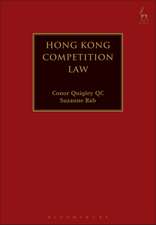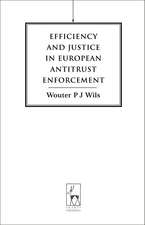Competition Law’s Innovation Factor: The Relevant Market in Dynamic Contexts in the EU and the US: Hart Studies in Competition Law
Autor Viktoria H S E Robertsonen Limba Engleză Paperback – 25 aug 2021
| Toate formatele și edițiile | Preț | Express |
|---|---|---|
| Paperback (1) | 315.54 lei 6-8 săpt. | |
| Bloomsbury Publishing – 25 aug 2021 | 315.54 lei 6-8 săpt. | |
| Hardback (1) | 601.85 lei 3-5 săpt. | |
| Bloomsbury Publishing – 5 feb 2020 | 601.85 lei 3-5 săpt. |
Din seria Hart Studies in Competition Law
- 30%
 Preț: 956.51 lei
Preț: 956.51 lei - 21%
 Preț: 275.26 lei
Preț: 275.26 lei - 18%
 Preț: 313.74 lei
Preț: 313.74 lei - 18%
 Preț: 313.07 lei
Preț: 313.07 lei - 22%
 Preț: 270.75 lei
Preț: 270.75 lei - 30%
 Preț: 540.54 lei
Preț: 540.54 lei - 27%
 Preț: 777.24 lei
Preț: 777.24 lei - 14%
 Preț: 893.15 lei
Preț: 893.15 lei - 30%
 Preț: 539.18 lei
Preț: 539.18 lei - 21%
 Preț: 217.35 lei
Preț: 217.35 lei -
 Preț: 365.91 lei
Preț: 365.91 lei - 22%
 Preț: 238.22 lei
Preț: 238.22 lei - 30%
 Preț: 779.09 lei
Preț: 779.09 lei - 18%
 Preț: 313.46 lei
Preț: 313.46 lei - 22%
 Preț: 261.17 lei
Preț: 261.17 lei - 23%
 Preț: 255.76 lei
Preț: 255.76 lei - 18%
 Preț: 299.96 lei
Preț: 299.96 lei - 21%
 Preț: 235.29 lei
Preț: 235.29 lei - 22%
 Preț: 250.09 lei
Preț: 250.09 lei - 18%
 Preț: 322.05 lei
Preț: 322.05 lei - 30%
 Preț: 894.38 lei
Preț: 894.38 lei - 22%
 Preț: 780.23 lei
Preț: 780.23 lei - 30%
 Preț: 539.57 lei
Preț: 539.57 lei - 24%
 Preț: 189.80 lei
Preț: 189.80 lei - 30%
 Preț: 837.39 lei
Preț: 837.39 lei -
 Preț: 319.13 lei
Preț: 319.13 lei - 22%
 Preț: 251.65 lei
Preț: 251.65 lei - 30%
 Preț: 569.22 lei
Preț: 569.22 lei - 30%
 Preț: 961.39 lei
Preț: 961.39 lei - 27%
 Preț: 1136.75 lei
Preț: 1136.75 lei
Preț: 315.54 lei
Nou
Puncte Express: 473
Preț estimativ în valută:
60.39€ • 62.81$ • 49.85£
60.39€ • 62.81$ • 49.85£
Carte tipărită la comandă
Livrare economică 14-28 aprilie
Preluare comenzi: 021 569.72.76
Specificații
ISBN-13: 9781509954681
ISBN-10: 1509954686
Pagini: 384
Dimensiuni: 156 x 234 mm
Greutate: 0.54 kg
Editura: Bloomsbury Publishing
Colecția Hart Publishing
Seria Hart Studies in Competition Law
Locul publicării:London, United Kingdom
ISBN-10: 1509954686
Pagini: 384
Dimensiuni: 156 x 234 mm
Greutate: 0.54 kg
Editura: Bloomsbury Publishing
Colecția Hart Publishing
Seria Hart Studies in Competition Law
Locul publicării:London, United Kingdom
Caracteristici
Explores the role of market definition in analysing competition law from the European perspective
Notă biografică
Viktoria H S E Robertson is Associate Professor at the University of Graz.
Cuprins
PART IMARKET DEFINITION AND INNOVATION1. IntroductionI. Innovation and the Relevant Market: The Issues at Stake II. The Parameters of this Study III. The Course of this Study 2. The Functions of the Relevant Market in EU Competition and US Antitrust Law I. The Relevant Product Market under US Antitrust Law II. The Relevant Product Market under EU Competition Law III. The Functions of the Relevant Product Market in the EU and the US: A First Comparative Look IV. No More Antitrust Market Definition? V. Conclusion 3. Innovation and Competition Law I. The Notion of Innovation II. Distinctive Features of Innovative Markets as Challenges for Antitrust Market Definition III. Perspectives on Incorporating Dynamic Competition into Antitrust IV. Conclusion PART IITHE INNOVATION FACTOR IN MARKET DELINEATION UNDER EU COMPETITION AND US ANTITRUST LAW4. Innovative Product Markets I. Innovative Products as a Challenge for Market Definition II. Product Differentiation Based on Innovation III. Innovation and the Time Horizon for Market Definition IV. The Definition of Future Markets V. Conclusion 5. Beyond Marked Definition: Potential Competition, R&D Markets and Innovation Competition I. Potential Competition in Innovative Markets II. The US Innovation Market Approach III. The Emergence of Innovation Competition IV. Conclusion 6. Intellectual Property Rights I. Market Definition and Intellectual Property Rights II. The Move Away from Intellectual Property Rights Seen as Conferring Market Power III. Market Definition in the Presence of Intellectual Property Rights IV. Technology Markets and the Licensing of Intellectual Property Rights V. Standard-Essential Patents and Product Market Definition: Just Another Technology Market? VI. Conclusion 7. Innovative Aftermarkets I. Policy Documents on Delineating Aftermarkets II. The Relationship between Primary and Secondary Markets III. Proprietary Primary Markets and Proprietary Aftermarkets IV. The Special Case of Aftermarkets in Franchises V. Conclusion 8. Platform Markets I. Market Definition in Platforms II. Free Services in Innovative Platform Markets III. Delineating Multi-sided Markets IV. Conclusion 9. Further Issues Concerning Innovation and Market Delineation I. Standard Economic Tests and Innovation II. Innovation and Geographical Market Definition III. Conclusion Conclusions on Part II: Accounting for Innovation When Delineating PART IIIRECONCEPTUALISING THE LEGAL FRAMEWORK FOR DELINEATING ANTITRUST MARKETS IN DYNAMIC CONTEXTS10. An Antitrust Framework for Delineating Dynamic Markets I. A Typology for Reconceptualising the Market Definition Framework II. Options for Market Definition Guidance in the Presence of Innovation III. Choosing a Market Definition Framework IV. The Guidance Options as a Way Towards Convergence in Market Definition? V. Conclusion 11. Reflections: Is Market Definition Too Big to Fail - or is it Failing Innovation?
Recenzii
This is a comprehensive and timely book on an important topic that is often overlooked in the literature . Professor Robertson has made a valuable contribution to the field . For anyone interested in the agency decisional practices, guidelines and case law on market definition in the European Union and the US, this is the go-to resource.
The author provides a deep analysis of case-law, law and soft law in order to clarify how the definition of relevant market as we know it may be aligned with the specific characteristics of dynamic markets . an extraordinarily interesting comparative study.
A most timely and important book . the planned revision of the 1997 Notice is a complex endeavour, which can significantly benefit from Professor Robertson's careful reflections.
Viktoria Robertson wrote an insightful book on market definition and innovation, which underpins analyses of both tech monopolization and mergers.
The author provides a deep analysis of case-law, law and soft law in order to clarify how the definition of relevant market as we know it may be aligned with the specific characteristics of dynamic markets . an extraordinarily interesting comparative study.
A most timely and important book . the planned revision of the 1997 Notice is a complex endeavour, which can significantly benefit from Professor Robertson's careful reflections.
Viktoria Robertson wrote an insightful book on market definition and innovation, which underpins analyses of both tech monopolization and mergers.











